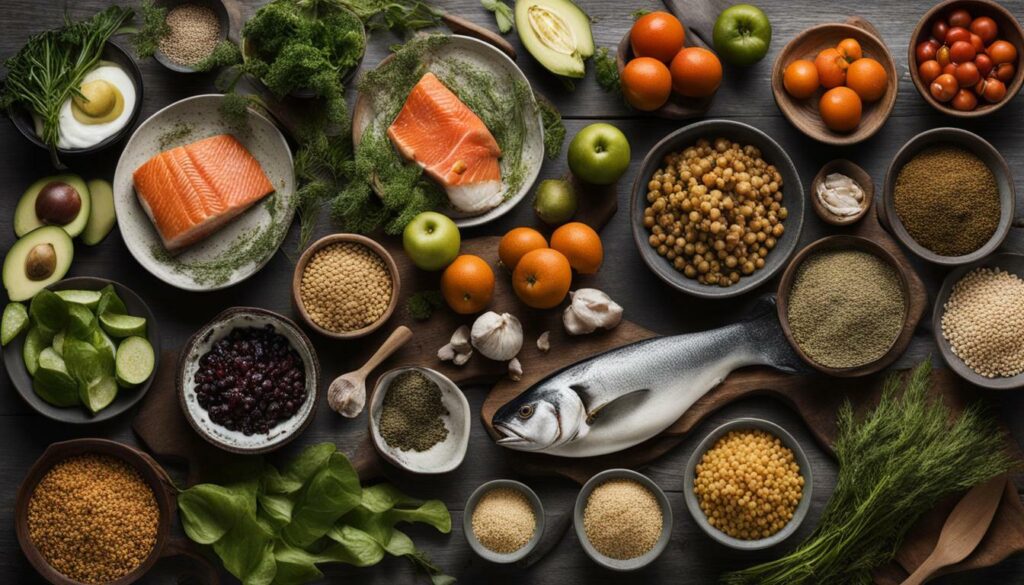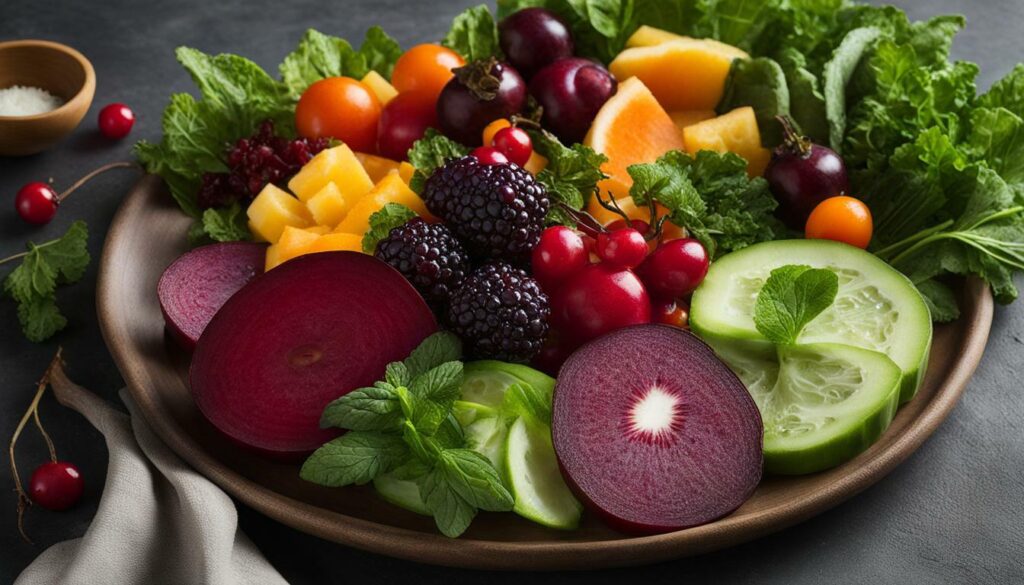Scandinavia has a rich culinary history, with its past and present diets reflecting a blend of tradition and cultural influences. Throughout history, the food traditions brought to North Dakota by Scandinavian immigrants have played a significant role in shaping the region’s cuisine. Lutefisk, lefse, and rye bread are just a few examples of the dishes that have become synonymous with Scandinavian food.
Key Takeaways:
- Scandinavian diets have evolved over time, influenced by historical and cultural factors.
- The New Nordic Diet (NND) promotes locally sourced and sustainably harvested foods.
- The Nordic diet shares similarities with the Mediterranean diet, focusing on whole foods and plant-based ingredients.
- The Nordic diet places a strong emphasis on environmentalism and ecological awareness.
- Modernization and changing lifestyles have posed challenges to traditional Scandinavian eating patterns.
Traditional Foods in Scandinavia
Traditional foods form the foundation of Scandinavian cuisine, showcasing the unique culinary traditions of the region. Scandinavia has a rich history of food, influenced by its geographical location and cultural heritage. From pickled herring to smoked salmon, these dishes have become iconic representations of Scandinavian cuisine.
One of the most beloved traditional foods in Scandinavia is lutefisk, which is made from dried whitefish that has been treated with lye. Despite its strong aroma, lutefisk is a staple during festive occasions and is often served with potatoes and peas. Another popular dish is lefse, a thin potato flatbread that is commonly enjoyed with butter and sugar.
Scandinavia is also known for its wide variety of bread, with rye bread being a staple in the region. Rye is a hardy grain that can withstand the harsh Nordic climate, and its dense and hearty bread has been a dietary staple for centuries. Traditional rye bread is typically dark in colour and has a slightly sour taste, making it a perfect accompaniment to cured meats and cheeses.
| Dish | Description |
|---|---|
| Lutefisk | A traditional dish made from dried whitefish treated with lye. |
| Lefse | A thin potato flatbread is often enjoyed with butter and sugar. |
| Rye Bread | A dense and hearty bread made from rye grain. |
The unique culinary traditions of Scandinavia have been passed down through generations, preserving the flavours and techniques that make these dishes so special. Whether it’s the simplicity of pickled herring or the complex flavours of gravlax, Scandinavian cuisine offers a truly sensory experience that reflects the region’s history and culture.

“Scandinavian cuisine offers a truly sensory experience that reflects the region’s history and culture.”
Evolution of Scandinavian Diets
The diets of Scandinavians have undergone significant changes throughout history, influenced by cultural shifts and the introduction of new ingredients and cooking techniques. Traditional Scandinavian cuisine was characterized by its reliance on locally available resources, such as seafood, game, and foraged plants. Staple foods included grains like barley, rye, and oats, as well as dairy products, particularly fermented ones like cheese and curdled milk.
Over time, Scandinavian diets have evolved, reflecting the impact of globalization and modernization. Popular Scandinavian dishes like gravlax (cured salmon) and Swedish meatballs have gained international recognition, while the consumption of processed and convenience foods has increased. This shift towards modern dietary patterns has brought about changes in eating habits, with Scandinavian countries witnessing a rise in the consumption of sugary drinks and snacks.
In recent years, there has been a growing awareness of the importance of nutrition and sustainability in Scandinavian diets. The New Nordic Diet (NND) has emerged as a contemporary approach that emphasizes locally sourced and sustainably harvested ingredients. The NND focuses on whole grains, fruits and vegetables, fish, and legumes, while reducing the intake of sweets, red meat, and high-fat dairy products. This culinary movement promotes both healthier eating habits and environmental consciousness.
It is worth noting the similarities between the Nordic diet and the Mediterranean diet. Both emphasize the consumption of whole foods, fish, and plant-based ingredients, which contribute to a balanced and nutrient-rich diet. Research has shown that these dietary patterns offer potential health benefits, including reduced risk of cardiovascular diseases and improved overall well-being.

The Nordic diet puts a strong emphasis on environmental sustainability, which reflects the cultural influences that have shaped Scandinavian food culture. The connection between food and the environment is deeply ingrained in Scandinavian traditions, with a focus on ethical sourcing, organic farming, and reducing food waste. This commitment to ecological awareness is not only beneficial for personal health but also for the planet.
In conclusion, the diets of Scandinavians have evolved over time, influenced by cultural shifts, globalization, and the growing awareness of nutrition and sustainability. From traditional cuisines to the emergence of the New Nordic Diet, Scandinavian diets reflect a balance between tradition and innovation, while also addressing environmental concerns. Further research is needed to continue exploring the changes in Nordic eating patterns and the diverse culinary traditions among the Nordic countries.
New Nordic Diet
The New Nordic Diet represents a modern interpretation of Scandinavian culinary tradition, promoting a healthy and sustainable approach to eating. This dietary pattern emphasizes locally sourced and sustainably harvested foods, whole grains, fruits and vegetables, fish, and legumes. The NND is lower in sweets, higher-fat red meat, and some higher-fat dairy products, aligning with the principles of a balanced and nutritious diet.

Incorporating traditional Scandinavian recipes and ingredients, the New Nordic Diet offers a variety of flavorful and nutrient-dense options. Traditional Scandinavian foods like herring, rye bread, and lingonberries are staple ingredients in this dietary approach. The use of fresh and seasonal produce, such as root vegetables and berries, adds vibrant colours and flavours to the dishes.
The environmental focus of the Nordic diet is also evident in the New Nordic Diet. By prioritizing locally sourced and ecologically sustainable ingredients, this dietary pattern supports the preservation of natural resources and reduces the carbon footprint associated with food production and transportation. It encourages individuals to make conscious choices that benefit both their health and the planet.
Traditional Scandinavian Recipes
Traditional Scandinavian recipes offer a window into the rich culinary heritage of the region. These dishes often showcase the use of local ingredients and reflect the cultural traditions of the Nordic countries. From Swedish meatballs and Danish smørrebrød to Norwegian salmon dishes and Finnish cinnamon buns, traditional Scandinavian recipes have gained international recognition for their simplicity and flavours.
| Traditional Scandinavian Recipes | Description |
|---|---|
| Lutefisk | A traditional Nordic dish made from dried whitefish that has been soaked in lye, resulting in a gelatinous texture. |
| Lefse | A soft and thin potato flatbread often served with butter, sugar, and cinnamon. |
| Rye bread | A dense and hearty bread made from rye flour, commonly enjoyed with butter, cheese, or cured meats. |
These traditional Scandinavian recipes have been passed down through generations, each with its unique flavours and cultural significance. They continue to be cherished and celebrated as part of the region’s culinary traditions.
Similarities to the Mediterranean Diet
The Nordic diet shares several similarities with the Mediterranean diet, both known for their potential positive impact on health and wellbeing. These two dietary patterns emphasize the consumption of whole foods, such as fruits, vegetables, whole grains, legumes, and fish. They also promote the use of healthy fats, such as olive oil and rapeseed oil, as well as moderate consumption of dairy products, especially yoghurt and cheese.
Both diets prioritize seasonal and locally sourced ingredients, focusing on high-quality, sustainable, and organic produce. This emphasis on fresh and unprocessed foods ensures that meals are rich in essential nutrients and antioxidants, supporting overall health and longevity.

Furthermore, the Nordic and Mediterranean diets share a cultural heritage that influences their culinary traditions. They both celebrate the gathering of family and friends around the table, encouraging a social and communal dining experience. This aspect of shared meals fosters a positive relationship with food and promotes mindful eating habits.
By incorporating these dietary patterns into their lifestyles, individuals can enjoy varied and balanced nutrition, reducing the risk of chronic diseases and improving overall well-being. The similarities between the Nordic and Mediterranean diets demonstrate the universal importance of consuming wholesome, unprocessed foods for optimal health.
Environmental Focus in the Nordic Diet
The Nordic diet goes beyond nutrition, with a strong focus on environmentalism and the preservation of Scandinavian food culture. It emphasizes sustainability, locally sourced ingredients, and ecological awareness, making it a unique and environmentally conscious dietary pattern.
Scandinavian food culture has always been closely tied to the region’s natural resources and seasons. Traditional dishes are often made with ingredients that are locally available, such as fish, berries, root vegetables, and whole grains. This connection to the environment has shaped not only the flavours but also the values of Scandinavian cuisine, with an emphasis on respect for nature and its offerings.

The Nordic diet embraces this cultural heritage and promotes a sustainable approach to eating. It encourages the consumption of seasonal, organic, and locally produced foods, reducing the carbon footprint associated with long-distance transportation and the use of chemical pesticides. By supporting local farmers and producers, the Nordic diet aims to preserve traditional food practices and safeguard the biodiversity of the region.
| Environmental Focus on the Nordic Diet |
|---|
| Emphasis on sustainability and ecological awareness |
| Utilizes locally sourced and seasonal ingredients |
| Promotes organic and sustainable farming practices |
| Reduces carbon footprint through local food production |
| Preserves traditional food practices and biodiversity |
By adopting the Nordic diet, individuals not only nourish their bodies but also contribute to the preservation of the environment and the cultural heritage of Scandinavia. This dietary pattern serves as a reminder of the value of sustainable food choices and the importance of aligning our eating habits with the well-being of the planet.
Modern Challenges and Eating Patterns
Modern lifestyles and changing food preferences have led to shifts in dietary habits and the emergence of new cuisines in Scandinavia. Convenience foods, globalization, and evolving societal norms have all influenced the way people eat in this region. Traditional staple foods are being replaced by modern-day cuisines that cater to busy schedules and changing tastes.
One major challenge is the increasing consumption of convenience foods. With hectic schedules and limited time for meal preparation, many Scandinavians are turning to ready-to-eat meals and fast food options. This shift in eating patterns has led to a decline in the consumption of traditional staple foods, such as fish, whole grains, and root vegetables.
Globalization has also had a significant impact on Scandinavian diets. The availability of international foods and the influence of global food trends have resulted in the adoption of new ingredients and cooking styles. Nordic cuisine is now a fusion of traditional Scandinavian flavours and international influences, reflecting the diverse cultural landscape of the region.
| Foods | Traditional | Modern |
|---|---|---|
| Fish | Salmon, herring | Sushi, fish tacos |
| Whole Grains | Rye bread, oatmeal | Quinoa, couscous |
| Root Vegetables | Potatoes, carrots | Sweet potatoes, zucchini |
“The increasing globalization and accessibility of international food options have introduced a wider variety of flavours and ingredients to Scandinavian diets,” says Dr. Emma Andersson, a nutritionist specializing in Scandinavian cuisine. “While this offers a more diverse culinary experience, it is important to strike a balance between embracing new food trends and preserving the traditional flavours that define Scandinavian cuisine.”
Impact on Health and Well-being
The shift towards modern-day cuisines in Scandinavia has raised concerns about the impact on health and well-being. Convenience foods and processed ingredients are often high in added sugars, unhealthy fats, and artificial additives. This can lead to an increase in chronic health conditions, such as obesity, diabetes, and cardiovascular disease.
However, there is also a growing movement towards healthier eating habits in the region. Many Scandinavians are becoming more conscious of their dietary choices and are opting for fresh, locally sourced ingredients. The New Nordic Diet (NND) is gaining popularity as it promotes a balanced approach to eating, focusing on whole foods, seasonal produce, and sustainable practices.

“The NND encourages the consumption of nutrient-dense foods that are beneficial for overall health,” explains Dr. Andersson. “By emphasizing whole grains, fruits and vegetables, fish, and legumes, the diet provides essential vitamins, minerals, and antioxidants that support optimal well-being.”
While modern challenges continue to shape dietary habits in Scandinavia, there is a renewed appreciation for the region’s culinary traditions. By striking a balance between convenience and nutrition, Scandinavians are navigating the complexities of modern eating patterns while preserving the cultural heritage that defines their cuisine.
Social Context and Eating Trends
To fully understand the evolution of Scandinavian cuisine and dietary practices, it is essential to consider the broader social context in which they occur. The culinary traditions of Scandinavia have been shaped by various factors, including socioeconomic status, cultural norms, and globalization. These influences have played a significant role in shaping the dietary habits of the region.
One notable trend in Scandinavian cuisine is the emphasis on locally sourced and sustainable ingredients. This focus is driven by a strong environmental consciousness within Scandinavian culture. By promoting the use of locally produced foods, Scandinavians aim to reduce carbon footprints and support local farmers and fishermen.
“Scandinavia has a rich food heritage that dates back centuries, and this heritage is deeply intertwined with the region’s natural resources and environment.”
This emphasis on environmentalism is also reflected in the New Nordic Diet (NND), which has gained popularity in recent years. The NND promotes the consumption of whole grains, fruits and vegetables, fish, and legumes while reducing the intake of sweets, higher-fat red meat, and some higher-fat dairy products. This dietary pattern aligns with the broader focus on sustainability and ecological awareness.
Modernization and globalization have brought about changes in Scandinavian eating patterns. Busy lifestyles and the availability of convenience foods have led to a shift towards modern-day cuisines. Traditional dishes are often adapted to fit into fast-paced, contemporary lifestyles, leading to changes in ingredients and preparation methods.
To fully grasp the complexities of Scandinavian diets, comprehensive research is needed. This includes examining the differences in concepts and vocabulary for meals among the Nordic countries and understanding the impact of socioeconomic factors on dietary choices. By delving deeper into these areas, we can gain valuable insights into the evolution of Scandinavian cuisine and the dietary practices of its people.

References:
- Berglund, M. (2012). The development of Swedish cuisine: A narrative analysis. Food, Culture & Society, 15(3), 375-394.
- Engeset, D., & Skuladottir, H. (2014). Nordic dietary recommendations: An integration of current knowledge. Food & Nutrition Research, 58(1), 1-10.
- Freire, P., & Berglund, M. (2013). Eating in-between Nordic countries: Borderlands, foodways and identities. Food, Culture & Society, 16(2), 261-279.
| Traditional Foods | Evolution of Diets | New Nordic Diet |
|---|---|---|
| Lutefisk | Introduction of convenience foods | Focus on locally sourced ingredients |
| Lefse | Globalization and changing lifestyles | Promotion of whole grains and vegetables |
| Rye bread | Integration of modern cooking techniques | Reduced intake of sweets and higher-fat meat |
Need for Further Research
Despite extensive research, there is still much to learn about the intricacies of Scandinavian dietary practices and the cultural nuances that shape them. While studies have provided valuable insights into past and present diets in Scandinavia, there are several areas that require further investigation to fully understand the complexities of the region’s culinary traditions.
One area that warrants further research is the concept of Scandinavian cuisine history. Although there is a wealth of knowledge about traditional foods and cooking methods, there is still much to explore in terms of the historical development of Scandinavian cuisines. This includes understanding the influences of neighbouring cultures, trade routes, and environmental factors on the evolution of food practices in the region.
Additionally, studies on Scandinavian food culture are needed to gain a deeper understanding of the social and cultural contexts in which dietary practices have evolved. This research could shed light on the role of food in Scandinavian identity and how it is intertwined with traditions, celebrations, and social interactions.
Another area that requires attention is the exploration of Scandinavian dietary practices in modern times. With globalization and changing lifestyles, there has been a shift in eating patterns and the adoption of new food habits. Further research is needed to investigate the impact of these changes on the nutritional quality of diets, as well as the implications for public health in the region.

| Research Areas | Keywords |
|---|---|
| Scandinavia Cuisine History | Scandinavia, Cuisine, History |
| Scandinavia Food Culture | Scandinavia, Food, Culture |
| Scandinavia Dietary Practices | Scandinavia, Dietary, Practices |
Conclusion
The past and present diets of Scandinavia offer a fascinating glimpse into the region’s culinary heritage, showcasing a blend of tradition, innovation, and cultural diversity. Scandinavian cuisine has a rich history, with traditional foods like lutefisk, lefse, and rye bread being brought to North Dakota by Scandinavian immigrants. These dishes reflect the influence of historical food traditions in Scandinavia.
However, the Scandinavian diet has also evolved over time, embracing new approaches such as the New Nordic Diet (NND). The NND emphasizes locally sourced and sustainably harvested foods, with a focus on whole grains, fruits and vegetables, fish, and legumes. This contemporary dietary pattern promotes health and sustainability, while also paying homage to traditional Scandinavian ingredients and flavours.
Interestingly, the Nordic diet shares similarities with the Mediterranean diet, both placing an emphasis on whole foods, fish, and plant-based ingredients. These dietary patterns have been associated with numerous health benefits, including lower rates of chronic diseases and longer life expectancy.
Furthermore, the Nordic diet embodies a strong environmental focus, valuing sustainability and ecological awareness. It recognizes the impact of food choices on the environment and promotes the use of locally sourced ingredients. This connection between food and the environment is deeply rooted in Scandinavian food culture and shapes the dietary practices of the region.
However, the modernization of society poses challenges to traditional eating patterns in Scandinavia. Convenience foods, globalization, and changing lifestyles have influenced the shift towards modern-day cuisines. Understanding these trends requires a broad social context, taking into account factors such as socioeconomic status, cultural norms, and globalization.
As the region continues to evolve, further research is needed to explore the changes in Nordic eating patterns and the differences in concepts and vocabulary for meals among the Nordic countries. Comprehensive studies will provide a deeper understanding of the complexities of Scandinavian diets and their cultural significance.
In conclusion, the past and present diets of Scandinavia are a testament to the region’s culinary heritage. From historical traditions to contemporary approaches, Scandinavian cuisine reflects a unique blend of tradition, innovation, and cultural diversity.
FAQ
What are some traditional foods in Scandinavia?
Traditional foods in Scandinavia include lutefisk, lefse, and rye bread.
What is the New Nordic Diet?
The New Nordic Diet is a contemporary approach to Scandinavian cuisine that emphasizes locally sourced and sustainably harvested foods, whole grains, fruits and vegetables, fish, and legumes.
How does the Nordic diet compare to the Mediterranean diet?
The Nordic diet and the Mediterranean diet share similarities, such as an emphasis on whole foods, fish, and plant-based ingredients.
What is the environmental focus of the Nordic diet?
The Nordic diet emphasizes sustainability, locally sourced ingredients, and ecological awareness.
What challenges do modernization and globalization present to Scandinavian eating patterns?
Modernization and globalization have influenced Scandinavian eating patterns through the influence of convenience foods and changing lifestyles.
Why is it important to consider the social context when studying Scandinavian eating trends?
The social context, including factors such as socioeconomic status and cultural norms, have played a role in shaping Scandinavian cuisine and dietary practices.
What further research is needed on Nordic eating patterns?
Further research is needed to understand changes in Nordic eating patterns and the differences in concepts and vocabulary for meals among the Nordic countries.
Source Links
- https://www.ndsu.edu/agriculture/extension/publications/exploring-north-dakota-foodways-scandinavian-cuisine-past-and-present
- https://www.lifeinnorway.net/nordic-diet/
- https://journals.openedition.org/aof/6997



